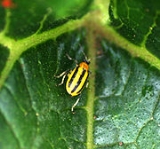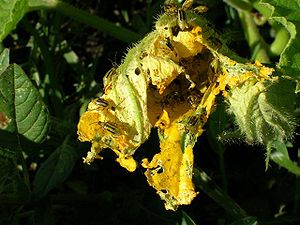
Striped cucumber beetle
Encyclopedia
The striped cucumber beetle, Acalymma vittatum, is a beetle
of the family Chrysomelidae and a serious pest of cucurbit
crops in both larval and adult stages.
(Diabrotica virgifera), another serious crop pest. However, the ventral abdominal surface of A. vittatum is black where that of D. virgifera are yellow, and the elytra of D. virgifera often do not extend the full length of the abdomen.
in the spring to feed on the foliage, flowers, and pollen of cucurbit species. Between one and two generations of beetles can pass in a season depending on the region, with the final generation settling into another period of diapause to wait out the winter.
Females will lay eggs on or in the immediate vicinity of the stem of a viable host plant, often a member of the genus Cucurbita
. Eggs are a bright orange color and less than a millimeter in diameter. Eggs hatch after a short period and larvae feed on the roots of the plant.
 Striped cucumber beetles can cause significant amounts of foliar damage to cucurbit crops, particularly to older plants, and larval root feeding also damages the plant. The most damage is often seen in the early part of the year during the emergence of overwintering beetles, but feeding damage continues throughout the entire growing season. Furthermore, adult beetles are one of two known vectors of the bacterial wilt Erwinia tracheiphila, an incurable and often fatal disease of cucurbits. Bacteria passes from the frass of the beetle into feeding wounds that reach into the vascular tissues of the plants, where they proliferate to the point of blocking the xylem
Striped cucumber beetles can cause significant amounts of foliar damage to cucurbit crops, particularly to older plants, and larval root feeding also damages the plant. The most damage is often seen in the early part of the year during the emergence of overwintering beetles, but feeding damage continues throughout the entire growing season. Furthermore, adult beetles are one of two known vectors of the bacterial wilt Erwinia tracheiphila, an incurable and often fatal disease of cucurbits. Bacteria passes from the frass of the beetle into feeding wounds that reach into the vascular tissues of the plants, where they proliferate to the point of blocking the xylem
.
, though not (E)-cinnamaldehyde. In Illinois, A. vittatum was found to be attracted to indole and (E)-cinnamaldehyde, but not 1,2,4-trimethoxybenzene.
and other biological control agents continues today. Another possibility is the planting of trap crops (crops that the beetles prefer) around the perimeter of the main crop. The trap crop can then be treated with insecticide, reducing overall pesticide use.
Some research indicates that striped cucumber beetle damage can be reduced by the use of vermicompost
fertilizer compared to inorganic fertilizer. Researchers suggest that the mechanism by which vermicompost reduces beetle damage is due to an increase in phenolic
compounds in plants grown with vermicompost.
The application of Paecilomyces Fumosoroseus
to a trap crop is an effective means of controlling the beetle.
, are induced to feeding behavior by a class of plant secondary compounds called cucurbitacins, widespread in members of the family Cucurbitaceae
. These extremely bitter chemicals are hypothesized to have evolved as a plant feeding defense, but have been co-opted by the beetles into a kairomonal feeding attractant. Beetles are capable of consuming amounts of cucurbitacins that would kill other organisms, and some work has indicated that the beetle may sequester the compounds in their elytra to deter predation.
Beetle
Coleoptera is an order of insects commonly called beetles. The word "coleoptera" is from the Greek , koleos, "sheath"; and , pteron, "wing", thus "sheathed wing". Coleoptera contains more species than any other order, constituting almost 25% of all known life-forms...
of the family Chrysomelidae and a serious pest of cucurbit
Cucurbitaceae
The plant family Cucurbitaceae consists of various squashes, melons, and gourds, including crops such as cucumber, pumpkins, luffas, and watermelons...
crops in both larval and adult stages.
Description
The striped cucumber beetle is a small beetle approximately half a centimeters in length, and characterized by brown-yellow elytra completely covering the abdomen and longitudinally transversed by three thick black stripes. It superficially resembles the western corn rootwormWestern corn rootworm
The Western corn rootworm, Diabrotica virgifera virgifera LeConte, is one of the most devastating corn rootworm species in North America, especially in the midwestern corn-growing areas such as Iowa. A related species, the Northern corn rootworm, D...
(Diabrotica virgifera), another serious crop pest. However, the ventral abdominal surface of A. vittatum is black where that of D. virgifera are yellow, and the elytra of D. virgifera often do not extend the full length of the abdomen.
Life cycle
Large numbers of adults emerge from diapauseDiapause
Diapause is the delay in development in response to regularly and recurring periods of adverse environmental conditions. It is considered to be a physiological state of dormancy with very specific initiating and inhibiting conditions...
in the spring to feed on the foliage, flowers, and pollen of cucurbit species. Between one and two generations of beetles can pass in a season depending on the region, with the final generation settling into another period of diapause to wait out the winter.
Females will lay eggs on or in the immediate vicinity of the stem of a viable host plant, often a member of the genus Cucurbita
Cucurbita
Cucurbita is a genus in the gourd family Cucurbitaceae first cultivated in Mesoamerica and now used in many parts of the world. It includes species grown for their fruit and edible seeds , as well as some species grown only as gourds...
. Eggs are a bright orange color and less than a millimeter in diameter. Eggs hatch after a short period and larvae feed on the roots of the plant.
Agricultural Damage

Xylem
Xylem is one of the two types of transport tissue in vascular plants. . The word xylem is derived from the Classical Greek word ξυλον , meaning "wood"; the best-known xylem tissue is wood, though it is found throughout the plant...
.
Chemical attractants
In Massachusetts, A. vittatum are attracted by several chemicals emitted by cucurbits, including 1,2,4-trimethoxybenzene and indoleIndole
Indole is an aromatic heterocyclic organic compound. It has a bicyclic structure, consisting of a six-membered benzene ring fused to a five-membered nitrogen-containing pyrrole ring. Indole is a popular component of fragrances and the precursor to many pharmaceuticals. Compounds that contain an...
, though not (E)-cinnamaldehyde. In Illinois, A. vittatum was found to be attracted to indole and (E)-cinnamaldehyde, but not 1,2,4-trimethoxybenzene.
Control Techniques
Grower tolerance for this beetle is very low, due in major part to the transmission of bacterial wilt. Unfortunately, effective control techniques beyond pesticides are few and far between. Research into nematodeNematode
The nematodes or roundworms are the most diverse phylum of pseudocoelomates, and one of the most diverse of all animals. Nematode species are very difficult to distinguish; over 28,000 have been described, of which over 16,000 are parasitic. It has been estimated that the total number of nematode...
and other biological control agents continues today. Another possibility is the planting of trap crops (crops that the beetles prefer) around the perimeter of the main crop. The trap crop can then be treated with insecticide, reducing overall pesticide use.
Some research indicates that striped cucumber beetle damage can be reduced by the use of vermicompost
Vermicompost
Vermicompost is the product or process of composting utilizing various species of worms, usually red wigglers, white worms, and earthworms to create a heterogeneous mixture of decomposing vegetable or food waste, bedding materials, and vermicast...
fertilizer compared to inorganic fertilizer. Researchers suggest that the mechanism by which vermicompost reduces beetle damage is due to an increase in phenolic
Polyphenol
Polyphenols are a structural class of natural, synthetic, and semisynthetic organic chemicals characterized by the presence of large multiples of phenol structural units...
compounds in plants grown with vermicompost.
The application of Paecilomyces Fumosoroseus
Paecilomyces fumosoroseus
Paecilomyces fumosoroseus is a microscopic fungus that infects and kills insects. It shows promise as a biological pesticide with an extensive host range.-Life cycle:...
to a trap crop is an effective means of controlling the beetle.
Cucumber beetles and Cucurbitacin
A. vittatum, along with other cucurbit-feeding beetles in the genus DiabroticaDiabrotica
Diabrotica is a widespread genus of beetles, sometimes referred to as cucumber beetles or corn rootworms, in the family Chrysomelidae. Members of this genus include several destructive agricultural pest species.-Range:...
, are induced to feeding behavior by a class of plant secondary compounds called cucurbitacins, widespread in members of the family Cucurbitaceae
Cucurbitaceae
The plant family Cucurbitaceae consists of various squashes, melons, and gourds, including crops such as cucumber, pumpkins, luffas, and watermelons...
. These extremely bitter chemicals are hypothesized to have evolved as a plant feeding defense, but have been co-opted by the beetles into a kairomonal feeding attractant. Beetles are capable of consuming amounts of cucurbitacins that would kill other organisms, and some work has indicated that the beetle may sequester the compounds in their elytra to deter predation.

